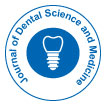Primary Stability of Short Dental Implants is Affected by the Length of the Implant and the Depth of the Insertion: An Investigation of a novel Artificial Bone Mandible Model in Vitro
Received Date: Sep 03, 2024 / Published Date: Sep 30, 2024
Abstract
Short dental implants (SDIs) have become a popular alternative in cases where anatomical constraints or insufficient bone volume preclude the use of longer implants. A key determinant of the success of dental implants is primary stability, which can be influenced by a variety of factors, including the length of the implant and its insertion depth. The aim of this study was to assess the primary stability of short dental implants, focusing on how the length and depth of insertion affect the outcomes in a novel artificial bone mandible model in vitro. The results suggest that both implant length and insertion depth play significant roles in primary stability, which has implications for the design and placement of short implants in clinical settings.
Keywords: Primary stability; short dental implants; implant length; insertion depth; artificial bone mandible model; in vitro study
Share This Article
Recommended Journals
Open Access Journals
Article Tools
Article Usage
- Total views: 234
- [From(publication date): 0-0 - Apr 02, 2025]
- Breakdown by view type
- HTML page views: 80
- PDF downloads: 154
